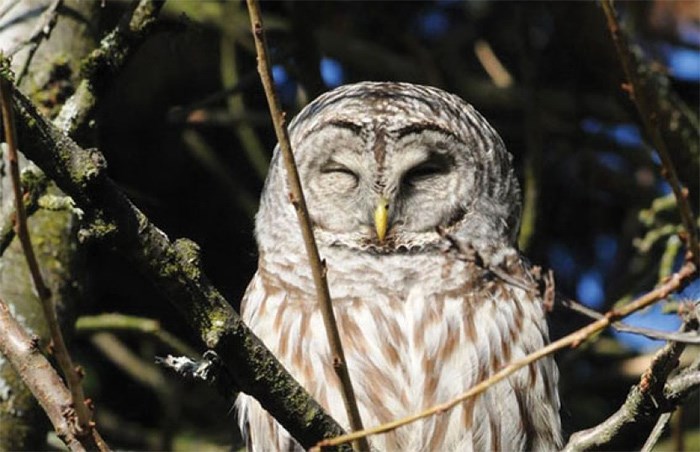 This owl in Ulrike Baumert’s North Â鶹´«Ă˝Ół»backyard was later found dead, likely from poison. photo supplied Ulrike Baumert
This owl in Ulrike Baumert’s North Â鶹´«Ă˝Ół»backyard was later found dead, likely from poison. photo supplied Ulrike Baumert
Animal lovers are urging residents on the North Shore to stop using rat poison after a number of owls have been inadvertently killed in recent weeks.
Lower Lonsdale resident Ulrike Baumert spotted a beautiful barred owl perched in her backyard last week. But the bird appeared lethargic and wouldn’t move from its branch. Then, one morning, she heard crows cawing in her yard and went to investigate.
“The owl was passed on,” Baumert said. “It fell out of the tree.”
Baumert called the Orphaned Wildlife (OWL) Rehabilitation Society in Delta, which sent a volunteer to collect the carcass for testing.
“Once they know what it is, they will let us know but the suspicion is, it is rat poisoning,” Baumert said.
The week before, volunteers picked up three dead owls, all from the Mosquito Creek corridor.
“The toxicology reports came back saying that indeed it was rat poison that they died of,” said Martina Versteeg, raptor care supervisor with OWL.
2017 has been a busy year for the volunteer-run and donation-funded organization, with 100 more admissions of sick birds than normal, Versteeg said
Once rats have consumed a poison like warfarin, it takes a while for them to die.
In that time, they may become prey to another animal, passing the toxins up the food chain.
“It’s secondary poisoning. It’s obviously not intentional but obviously poison doesn’t really differentiate what it’s poisoning,” she said.
Most rat poisons are blood thinners that cause animals to become sick and slowly die.
“They could just bleed out. They could have an aneurysm. They could have a heart attack or stroke,” Versteeg said. “They just hemorrhage, basically.”
It’s likely there are other cases of owls being accidentally poisoned, Versteeg said, but volunteers simply haven’t come by their remains and had them tested to be sure.
It is perfectly legal to use poison but Baumert said her family stopped years ago over fears other wildlife or pets would be harmed.
Now she would like others to do the same.
“I would like people to be more aware of what it can do,” she said. “I would love to see that nobody uses it anymore.”
That’s something OWL has been advocating for years, Versteeg said.
“I think people are just squeamish… and they want to have the fast option. If they get told it’s relatively safe, they’ll just go for it.
But without considering all the side effects, once people start they usually just continue it,” she said.
“There’s just a constant stream of poisoning being put out there.”
If people want to deal with a rat problem, it would be much better for them to start by managing the attractants that draw rats out in the first place, Versteeg said.
OWL would prefer people use mechanical or electrical traps as a humane alternative.
“It’s much quicker and it’s species-specific,” Versteeg said.


